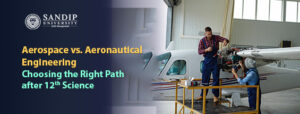Selecting the best course after 12th science can significantly impact your career trajectory. For students fascinated by the mechanics of flight and space, Aerospace and Aeronautical Engineering present exciting opportunities. Both fields offer unique challenges and rewarding careers, but understanding their differences is crucial in making an informed decision. Sandip University, renowned as one of the best engineering colleges in Nashik, provides excellent programs in these fields, making it a prime choice for aspiring engineers. This article delves into the distinctions between Aerospace and Aeronautical Engineering, their career scopes, and why Sandip University stands out as a top educational institution.
Aerospace Engineering: Exploring the Beyond
Aerospace Engineering encompasses the design, development, testing, and production of aircraft, spacecraft, and related systems. This field extends beyond the Earth’s atmosphere, covering both atmospheric and space vehicles. It integrates elements from mechanical, electrical, and materials engineering to innovate and enhance technologies for aviation and space exploration.
Career Scope After Aerospace Engineering
1) Aviation Sector
Aerospace engineers play a pivotal role in designing and improving commercial, military, and cargo aircraft. They ensure that these machines are efficient, safe, and reliable.
2) Space Exploration
Opportunities abound in space agencies like ISRO and NASA, where aerospace engineers contribute to the development of satellites, space probes, and manned space missions. The space industry is growing rapidly, offering numerous roles in research, development, and mission planning.
3) Defense Industry
Aerospace engineers are essential in the defense sector, working on advanced fighter jets, drones, and missile systems. Their expertise ensures that national security remains robust and technologically advanced.
4) Research and Development
The field encourages continuous innovation. Aerospace engineers engage in cutting-edge research to develop new technologies, materials, and systems, driving progress in aviation and space travel.
Aeronautical Engineering: Mastering Flight
Aeronautical Engineering is a specialized branch within aerospace engineering focused exclusively on the development, testing, and maintenance of aircraft that operate within Earth’s atmosphere. This discipline emphasizes aerodynamics, propulsion systems, avionics, and structural design of aircraft.
Career Scope After Aeronautical Engineering
1) Commercial Aviation
Aeronautical engineers work with major airlines and aircraft manufacturers, designing and maintaining passenger planes. They ensure that these aircraft meet safety regulations and performance standards.
2) Military Aviation
This sector offers roles in designing and maintaining military aircraft, including fighter jets, transport planes, and helicopters. Aeronautical engineers contribute to national defense by enhancing the capabilities of air forces.
3) Aerospace Manufacturing
Engineers in this field are involved in the production and testing of aircraft components and systems. They work with advanced materials and technologies to improve the efficiency and safety of aviation products.
4) Regulatory Bodies
Aeronautical engineers may work with aviation regulatory bodies, ensuring that aircraft comply with safety and environmental regulations. They play a critical role in establishing standards and conducting inspections.
Why Sandip University?
Sandip University is recognized as one of the best engineering colleges in Nashik, offering top-notch programs in both Aerospace and Aeronautical Engineering. Here’s why it stands out:
1) State-of-the-Art Facilities
Sandip University provides cutting-edge laboratories, wind tunnels, and simulation facilities that give students hands-on experience and a deep understanding of engineering principles.
2) Experienced Faculty
The university boasts a team of highly qualified faculty members with extensive industry experience and academic excellence, guiding students through their educational journey.
4) Strong Industry Connections
Sandip University maintains robust partnerships with leading aerospace and aviation companies, facilitating internships, workshops, and placement opportunities that bridge the gap between academia and industry.
5) Holistic Development
Beyond academics, the university focuses on the overall development of students through extracurricular activities, seminars, and value-added programs, ensuring they are well-rounded professionals.
Conclusion
Choosing between Aerospace and Aeronautical Engineering depends on your interests and career goals. Both fields offer extensive career scopes and exciting opportunities. Sandip University, a top Aeronautical Engineering college in Maharashtra, provides exceptional education and resources to help you succeed in either path. By opting for the best course after 12th science at Sandip University, you can embark on a fulfilling and successful career in the dynamic fields of Aerospace or Aeronautical Engineering.






